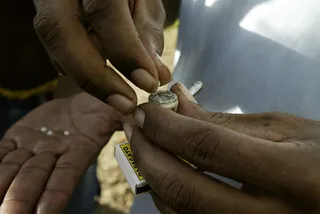The 411 on Crack Cocaine
Read more about crack and its impact in the Black community.

1 / 9
Mayor Rob Ford and Crack Cocaine - With the media breaking news that Toronto Mayor Rob Ford smokes crack cocaine, the drug has gotten a lot of attention. But do you really know what crack is? Read more about the highly addictive drug and its impact in the Black community. —Kellee Terrell (Photo: AP Photo/The Canadian Press, Chris Young)

2 / 9
What Is Crack Cocaine? - Crack is the crystal form of cocaine, which is a powder. Crack is heated or smoked and its name comes from the sound that it makes when it’s smoked. It is a highly addictive stimulant and people on it can and will do anything to keep that high. It’s estimated that 14 percent of Americans have tried a form of cocaine in their lifetime.(Photo: David McNew/Getty Images)

3 / 9
What Crack Does to Your Body - In the short term, the drug can “constrict peripheral blood vessels, dilate pupils, increase temperature, heart rate, blood pressure, insomnia, loss of appetite, feelings of restlessness, irritability and anxiety,” writes DrugFreeOrg. Long-term effects from crack include severe depression, heart disease, stroke, respiratory failure, brain seizures, sexual dysfunction, delirium or psychosis, reproductive damage and infertility, risky sexual behavior and death.(Photo: Neil Borden/Getty Images)

4 / 9
Overcoming Crack Addiction - Withdrawal symptoms are more emotional than physical. The first step of overcoming a crack addiction is detox. After detox, some may go to a rehab center that deals with therapy to address the addiction and past emotional issues that may have put you at risk for addiction. Rehab can last 30 days or longer. From there, an addict is released and may choose to attend 12-step meetings to maintain a successful recovery. (Photo: Chicago Tribune/MCT /Landov)

5 / 9
Crack vs. Cocaine - Crack is the purest form of the drug, making it the most dangerous. Crack is made by a chemical process that allows for the drug to be in its "freebase" form in order to be smoked, says Web Med. Also, crack is much cheaper than cocaine and is associated with poverty. Cocaine, the powder form, is extremely expensive and associated with models, Wall Street folks and celebrities. (Photo: Yvonne Hemsey/Getty Images)
ADVERTISEMENT

6 / 9
African-Americans and Crack - It’s not a secret that the crack epidemic disproportionately affected poor African-American communities in the ‘80s and ‘90s. There is a widespread belief that the U.S. government placed crack in Black communities to lessen its political power and fragment us even more. However, there isn’t concrete proof to prove that to be true. (Photo: REUTERS/Oswaldo Rivas)
Photo By Photo:Oswaldo Rivas/ REUTERS

7 / 9
The Myth of the Crack Baby - When crack hit and began devastating our community, there was much worry (and media hype) that babies born addicted to crack would have serious behavior and development issues. However, a series of 2013 studies found that these projections were unwarranted and untrue. It’s actually believed that poverty has more of an affect on Black children’s outcomes than crack. (Photo: FRED DUFOUR/AFP/Getty Images)

8 / 9
The Disparities of Crack - In the past, being arrested with crack carried a harsher penalty than cocaine: Crack possession can mean a decade behind bars while cocaine can mean probation, writes the Huffington Post. Eighty percent of those arrested for crack cocaine are African-American. (Photo: John Chiasson/Liaison)
